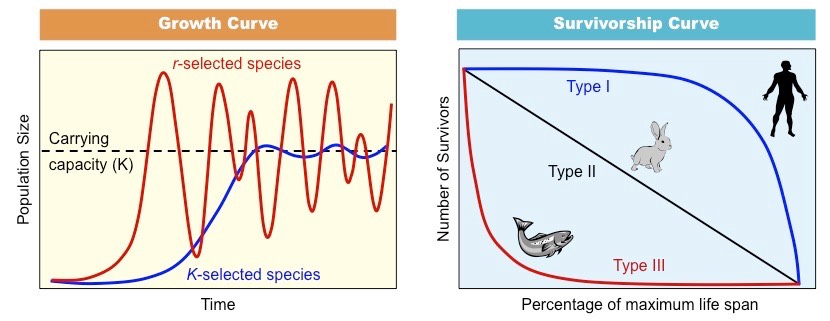Karla Jauregui Sandoval
Jillian Holbrook
AP Environmental Science ♻️
252 resourcesSee Units
Differential Reproductive Strategies
Population rates for species depend on the effectiveness of their reproductive strategies. Through comparing the reproductive strategies of species, we are prompted to ask:
In ecology, the terms "r-selected" and "K-selected" refer to the two ends of a spectrum of reproductive strategies that species can adopt.
R-selected species are those that have a high rate of reproduction and low investment in individual offspring. These species are adapted to environments where resources are scarce and unpredictable, and their strategy is to produce many offspring with the hope that a few will survive to reproduce. Examples of r-selected species include annual plants, insects, and some small mammals. 🐁
K-selected species, on the other hand, have a low rate of reproduction and a high investment in individual offspring. These species are adapted to environments where resources are more stable, and their strategy is to produce a smaller number of offspring but to use more resources in their survival. Examples of K-selected species include large mammals. 🐘

Image Courtesy of BioNinja
Biotic potential refers to the maximum reproductive rate of a population in ideal conditions. It is determined by the rate of reproduction and survival of the species, as well as the availability of resources.
If a species has a high biotic potential and is able to reproduce and survive at high rates, it will have the potential to grow and expand its range quickly. On the other hand, if a species has a low biotic potential and is unable to reproduce and survive at high rates, it will have a slower rate of population growth and may be more vulnerable to extinction.
Characteristics of K-Selected Species

Image Courtesy of Pixabay
A K-selected species can be described as larger species and tend to consist of terrestrial mammals. These species invest a lot of parental care into raising their offspring, which is why their family sizes, or numbers of offspring, are smaller.
Because significant time, energy, and resources are invested into child rearing, K-selected species tend to have a Type I and Type II survivorship curve. Offspring live longer lives and grow slowly through an extended period of youth until their habitat hits the carrying capacity. K-selected species reproduce more than once in their lifetime, but competition for resources tends to be relatively high.
Characteristics of R-Selected Species

Image Courtesy of Pixabay
R-selected species are generally small, and parents invest little time and energy into parental care. The family size of these species is large! R-selected species have many offspring per reproductive age. However, r-selected species have a Type III survivorship curve, which means a shorter lifespan and that most offspring die off at an early age.
Because r-selected species must adapt quickly to their unpredictable habitats, these species experience lower competition for resources. However, r-selected species tend to only reproduce once in their lifetime.
Comparing K-Selected and R-Selected Species
K-selected | r-selected | |
Size | Generally larger as species (terrestrial mammals) | Generally small |
Parenting | LOTS of parental care ➪time, energy, and resources in child rearing | Parents invest a little amount of time. energy and resources in children |
Family Size | Small ➪ few offspring per reproductive event ➪ long lifespans ➪ grow slowly until they hit carrying capacity | Large offspring per reproductive event ➪ short lifespan ➪ fast sexual maturity ➪ grow quickly but are followed by overshoots and die-offs - predator-prey relationships |
Competition | Highly competitive for resources (crowded niches) | Low competition for resources ➪ adapt quickly |
Eco. Succession | Late stage successors | Pioneer species |
Invasive species | Mostly affected by invasive species | Most invasive species are r selected because they reproduce quickly |
Examples | Humans, eagles, elephants, parrots, bison, and bears. | Insects, mice, bacteria, grasses, |
🎥 Watch this video here at 34 minutes to discuss this key topic more!
Browse Study Guides By Unit
🏜Unit 1 – The Living World: Ecosystems
🐠Unit 2 – The Living World: Biodiversity
👪Unit 3 – Populations
🌏Unit 4 – Earth Systems & Resources
🏖Unit 5 – Land & Water Use
⚡️Unit 6 – Energy Resources & Consumption
💨Unit 7 – Atmospheric Pollution
♻️Unit 8 – Aquatic & Terrestrial Pollution
🔥Unit 9 – Global Change
📚Study Tools
🤔Exam Skills

Fiveable
Resources
© 2025 Fiveable Inc. All rights reserved.